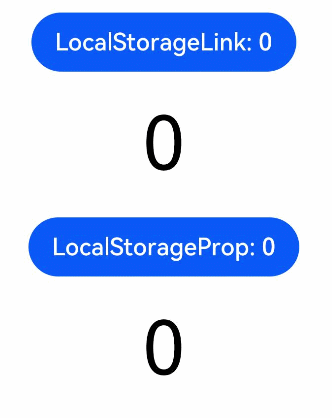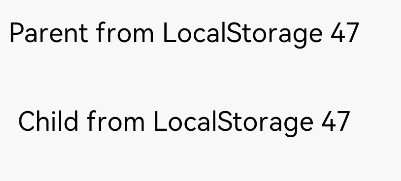harmony 鸿蒙State Management with Application-level Variables
State Management with Application-level Variables
This topic covers how to manage the application status with application-level variables. For details about the APIs, see State Management with Application-level Variables.
AppStorage
The AppStorage is a singleton object in an application that provides central storage for changing state attributes of an application. It is created by the UI framework when the application is started and destroyed when the application exits.
The AppStorage contains all the state attributes that need to be accessed throughout the application. It retains all attributes and their values as long as the application remains running, and the attribute values can be accessed through unique key values.
Components can synchronize the application state data with the AppStorage through decorators. The application service logic can also be implemented by accessing the AppStorage through APIs.
The selection state attribute of the AppStorage can be synchronized with different data sources or data sinks. These data sources and data sinks can be local or remote devices and provide different functions, such as data persistence. Such data sources and data sinks can be implemented independently of the UI in the service logic.
By default, the attributes in the AppStorage are mutable. If needed, AppStorage can also use immutable (read-only) attributes.
NOTE
Worker can interact with the main thread only through postMessage.
@StorageLink Decorator
Two-way data binding can be established between components and the AppStorage through state variables decorated by @StorageLink(key). Wherein, key is the attribute key value in the AppStorage. When a component containing the @StorageLink decorated variable is created, the variable is initialized using the value in the AppStorage. Changes made to this variable in the component will be first synchronized to the AppStorage, and then to other bound instances, such as PersistentStorage or other bound UI components.
@StorageProp Decorator
One-way data binding can be established between components and the AppStorage through state variables decorated by @StorageProp(key). Wherein, key is the attribute key value in the AppStorage. When a component containing the @StorageProp decorated variable is created, the variable is initialized using the value in the AppStorage. Changes made to the value in the AppStorage will cause the bound UI component to update the state.
Example
Each time the user clicks the Count button, the value of this.varA will increase by 1. This variable is synchronized with varA in the AppStorage. Each time the user clicks the language button, the value of languageCode in the AppStorage will be changed, and the change is synchronized to the this.languageCode variable.
// xxx.ets
@Entry
@Component
struct ComponentA {
@StorageLink('varA') varA: number = 2
@StorageProp('languageCode') languageCode: string = 'en'
private label: string = 'count'
aboutToAppear() {
this.label = (this.languageCode === 'en') ? 'Number' : 'Count'
}
build() {
Column() {
Row({ space: 20 }) {
Button(`${this.label}: ${this.varA}`)
.onClick(() => {
AppStorage.Set<number>('varA', AppStorage.Get<number>('varA') + 1)
})
Button(`language: ${this.languageCode}`)
.onClick(() => {
if (AppStorage.Get<string>('languageCode') === 'zh') {
AppStorage.Set<string>('languageCode', 'en')
} else {
AppStorage.Set<string>('languageCode', 'zh')
}
this.label = (this.languageCode === 'en') ? 'Number' : 'Count'
})
}
.margin({ top: 50, bottom: 50 })
Row() {
Button (`Change @StorageLink decorated variable: ${this.varA}`).height(40).fontSize(14)
.onClick(() => {
this.varA++
})
}
}.width('100%')
}
}

LocalStorage
NOTE
This API is supported since API version 9. Updates will be marked with a superscript to indicate their earliest API version.
The LocalStorage is a storage unit in an application. Its lifecycle follows its associated ability. In the stage model, the LocalStorage provides global data isolation between abilities and applies to where a data sharing scope smaller than that provided by the AppStorage is required. The LocalStorage also provides storage for application-wide mutable and immutable state attributes, which are used for building part of the application UI, such as an ability UI. The LocalStorage resolves the data interference between the application and the abilities and, in multi-instance scenarios, data interference between different Ability instances under the same Ability class. In distributed migration scenarios, Ability, as the minimum unit for the system to schedule applications, allows for easier component data migration when working with the LocalStorage.
At the application layer, multiple LocalStorage instances can be created for an application, each corresponding to an ability of the application.
An application can have multiple abilities. At most one LocalStorage instance can be allocated to the components in an ability. In addition, all components in the ability inherit access to the objects stored in the LocalStorage instance.
A component can access a maximum of one LocalStorage instance, and one LocalStorage instance can be assigned to multiple components.
@LocalStorageLink Decorator
Two-way data binding can be established between a component and the LocalStorage through the component’s state variable decorated by @LocalStorageLink(key). Wherein, key is the attribute key value in the LocalStorage. When a component that contains a @LocalStorageLink decorated state variable is created, the state variable is initialized with the initial value in the LocalStorage. If no initial value is assigned in the LocalStorage, the state variable will use the value defined by @LocalStorageLink. Changes made to the @LocalStorageLink decorated variable in a component will be first synchronized to the LocalStorage, and then to other bound UI components under the same ability.
@LocalStorageProp Decorator
One-way data binding can be established between a component and the LocalStorage through the component’s state variable decorated by @LocalStorageProp(key). Wherein, key is the attribute key value in the LocalStorage. When a component that contains a @LocalStorageProp decorated state variable is created, the state variable is initialized with the initial value in the LocalStorage. Changes made to the value in the LocalStorage will cause all UI components under the current ability to update the state.
NOTE
If a LocalStorage instance does not have an initial value assigned when being created, it can use the initial value defined by @LocalStorageLink or @LocalStorageProp in the component.
Example 1: Creating a LocalStorage Instance in an Ability
The LocalStorage is loaded through the loadContent API. For details, see loadContent.
import UIAbility from '@ohos.app.ability.UIAbility';
export default class EntryAbility extends UIAbility {
storage: LocalStorage
onCreate() {
this.storage = new LocalStorage()
this.storage.setOrCreate('storageSimpleProp', 121)
console.info('[Demo EntryAbility onCreate]')
}
onDestroy() {
console.info('[Demo EntryAbility onDestroy]')
}
onWindowStageCreate(windowStage) {
// storage is passed to the loadContent API as a parameter.
windowStage.loadContent('pages/index', this.storage)
}
onWindowStageDestroy() {
console.info('[Demo] EntryAbility onWindowStageDestroy')
}
onForeground() {
console.info('[Demo] EntryAbility onForeground')
}
onBackground() {
console.info('[Demo] EntryAbility onBackground')
}
}
The @Component decorated component obtains data.
// index.ets
let storage = LocalStorage.GetShared()
@Entry(storage)
@Component
struct LocalStorageComponent {
@LocalStorageLink('storageSimpleProp') simpleVarName: number = 0
build() {
Column() {
Button(`LocalStorageLink: ${this.simpleVarName.toString()}`)
.margin(20)
.onClick(() => {
this.simpleVarName += 1
})
Text(JSON.stringify(this.simpleVarName))
.fontSize(50)
LocalStorageComponentProp()
}.width('100%')
}
}
@Component
struct LocalStorageComponentProp {
@LocalStorageProp('storageSimpleProp') simpleVarName: number = 0
build() {
Column() {
Button(`LocalStorageProp: ${this.simpleVarName.toString()}`)
.margin(20)
.onClick(() => {
this.simpleVarName += 1
})
Text(JSON.stringify(this.simpleVarName))
.fontSize(50)
}.width('100%')
}
}

Example 2: Defining LocalStorage on the Entry Page
// xxx.ets
let storage = new LocalStorage({ "PropA": 47 })
@Entry(storage)
@Component
struct ComA {
@LocalStorageLink("PropA") storageLink: number = 1
build() {
Column() {
Text(`Parent from LocalStorage ${this.storageLink}`)
.fontSize(18)
.margin(20)
.onClick(() => this.storageLink += 1)
Child()
}
}
}
@Component
struct Child {
@LocalStorageLink("PropA") storageLink: number = 1
build() {
Text(`Child from LocalStorage ${this.storageLink}`)
.fontSize(18)
.margin(20)
.onClick(() => this.storageLink += 1)
}
}

PersistentStorage
PersistentStorage provides a set of static methods for managing persistent data of applications. Persistent data with specific tags can be linked to the AppStorage, and then the persistent data can be accessed through the AppStorage APIs. Alternatively, the @StorageLink decorator can be used to access the variable that matches the specific key.
NOTE
- When using the PersistProp API in PersistentStorage, ensure that the input key exists in the AppStorage.
- The DeleteProp API in PersistentStorage takes effect only for the data that has been linked during the current application startup.
// xxx.ets
PersistentStorage.PersistProp('highScore', '0')
@Entry
@Component
struct PersistentComponent {
@StorageLink('highScore') highScore: string = '0'
@State currentScore: number = 0
build() {
Column() {
if (this.currentScore === Number(this.highScore)) {
Text(`new highScore : ${this.highScore}`).fontSize(18)
}
Button(`goal!, currentScore : ${this.currentScore}`)
.margin(20)
.onClick(() => {
this.currentScore++
if (this.currentScore > Number(this.highScore)) {
this.highScore = this.currentScore.toString()
}
})
}.width('100%')
}
}

Environment
Environment is a singleton object created by the framework when the application is started. It provides the AppStorage with an array of environment state attributes required by the application. These attributes, such as the system language and color mode, describe the device environment where the application runs. Environment and its attributes are immutable, and all attribute values are of simple types. The following example shows how to obtain whether accessibility is enabled from Environment:
Environment.EnvProp('accessibilityEnabled', 'default')
var enable = AppStorage.Get('accessibilityEnabled')
accessibilityEnabled is the default system variable identifier provided by Environment. You need to bind the corresponding system attribute to the AppStorage. Then, you can use the methods or decorators in the AppStorage to access the corresponding system attribute data.
你可能感兴趣的鸿蒙文章
harmony 鸿蒙app.json5 Configuration File
harmony 鸿蒙Internal Structure of the app Tag
harmony 鸿蒙Application Configuration File Overview (FA Model)
harmony 鸿蒙Application Configuration File Overview (Stage Model)
harmony 鸿蒙Application Installation and Uninstallation Process
harmony 鸿蒙Application Package Overview
harmony 鸿蒙Application Package Structure in FA Model
- 所属分类: 后端技术
- 本文标签: